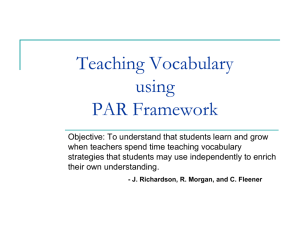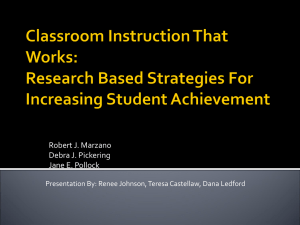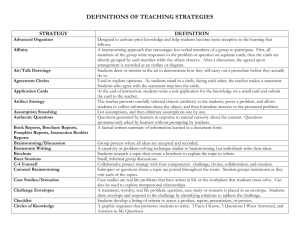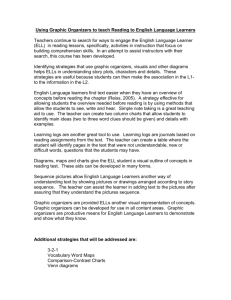What is it like?
advertisement
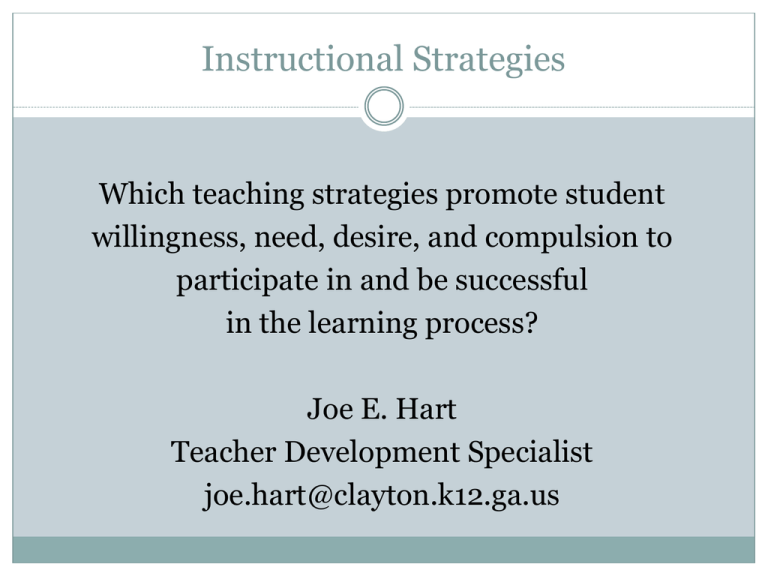
Instructional Strategies Which teaching strategies promote student willingness, need, desire, and compulsion to participate in and be successful in the learning process? Joe E. Hart Teacher Development Specialist joe.hart@clayton.k12.ga.us Website Links The following link will get you to the LiveText Link and the Workshop Evaluation link. http://heritagekids.info/ This link will take you to LiveText to download items for the workshop. https://c1.livetext.com/doc/7901981#79 Use this link to evaluate the workshop. http://clayton.us2.qualtrics.com/SE/?SID=SV_0q8t vG4yKiiQMqE 1 2 3 4 Z k F 5 p You will have 12 seconds to look at 6 H 7 12 Letters of the alphabet I y 8 9 N A 10 j q g 11 12 Identifying Similarities and Differences Comparison Tasks Classifying Tasks Metaphors Analogies http://www.sadlier- oxford.com/phonics/ana logies/analogiesx.htm Metaphorical Thinking Example: The Saguaro Cactus is like an apartment. Animals live on different floors and as one moves out – another moves in. Analogies A thinking skill demonstrated by a student when he or she can give examples similar to, but not identical to a target example. Examples, the Internet is analogous to the post office (because in both, multimedia information is delivered to specific addresses). A jumbo jet is like an albatross in that they both fly, they both have wings, they can both travel for a long way without landing, and both can sense where they are going; but they are unlike in that they have different means of propulsion, are made of different materials, etc. http://www.sadlier-oxford.com/phonics/analogies/analogiesx.htm Four Box Synectics Summarizing and Note Taking Nonlinguistic Representations Nonlinguistic Representations Concept Map Mnemonic Devices A mnemonic device is a memory aid. New knowledge is more effectively stored in the long term memory when it is associated with anything that is familiar. Science King Philip Cuts Open Five Green Snakes Kingdom, Phylum, Class, Order, Family, Genus, Species This is only one of innumerable mnemonics used to remember the order of Taxonomy for biology a rat in the house may eat the ice cream Cooperative Learning Create Opportunities for students to collaborate and explain their thinking. Graphic Organizers Graphic Organizers are visual representations of a text or a topic. Many students are visual learners. Organizers provide frames for students or teachers to identify pertinent facts, to organize information, and to record relationships between facts and ideas within a learning task. Graphic Organizers Having a way to organize ideas, facts, and concepts graphically facilitates effective student learning and helps students maintain information over a period of time. Graphic organizers are called a variety of names, including knowledge maps, story maps, concept maps, mind maps, cognitive organizers, advance organizers, or concept diagrams. Always use a graphic organizer! Quadrilaterals (A figure bounded by four distinct line segments) Parallelogram Trapezoid (opposite sides congruent and parallel) (One pair of opposite sides parallel) Rectangle Rhombus (4 right angles) (All sides are congruent) Square (4 right angles and 4 congruent sides) Prior Knowledge Remember that students construct meaning by recalling prior knowledge and linking it to new knowledge. It is like tilling the soil before planting the seeds. What does this mean for your classroom? Activating Strategy 5-3-1 A 5-3-1 is a good summarizing strategy! Students individually list 5 things they learned during the lesson or unit. With a partner, students narrow their lists to three things. With another pair, students narrow the list to the one most important thing the learned. This can also be called a Think Pair Square (individually, with a partner, with another pair which makes a square) • A 3-2-1 is a good summarizing or group strategy and can be used just like a 5-3-1. •Students individually list 3 things they learned during the lesson or unit. •With a partner, students narrow their lists to 2 things. •With another pair, students narrow the list to the one most important thing the learned. •Or you can use a 3-2-1 as a closing activity. •Please write 3 differences between the characters of the novel. •Please write 2 similarities between the characters. •Please write 1 question you’d like to ask any character. •Please write 3 causes of the war. •Please write 2 things that bothered you the most. •Please write 1 piece of advice you would have given the president at that time. •You get the idea. You have asked students to think about today’s class and pull all their newly gained information together in some way. A B C D E F G H I J K L M N O P Q R S T U V W X Y Z As a summarizer, have student write a word or group of words beginning with each letter of the alphabet about the current topic of study. First Word M Metal objects are attracted to magnets A G N E T S Activating Strategy P I L G R I M S Plymouth Colony, Plymouth Rock Insisted on the right to religious ideals, Leaders (William Bradford, William Brewster, John Alden) Governor Bradley reelected 30 x, Reformation, refuge, religious sanctuary The Last Word Massachusetts, Miles Standish, Mayflower compact Separatists (English), Scrooby Separatists, settlers, M Most frequently occurring number in a set O Often there is more than one in a large set of numbers D Data doesn’t always have a mode E Easy to determine, simply count how often the numbers occur M E A N The Last Word Compare and Contrast Web Unique Characteristics Pearl Harbor Similar Characteristics Unique Characteristics 911 Terrorist Attack Opal How we are alike Me ______________________________________________________________________ ______________________________________________________________________ ______________________________________________________________________ ______________________________________________________________________ ______________________________________________________________________ ______________________________________________________________________ ______________________________________________________________________ Go to www.wordle.net and create a wordle about your new unit. Have students brainstorm what they think you will be studying and what will be important. This is a great Activating Strategy. It is a great Hook for your Opening. Inner Outer Circle ½ of the group make a circle facing inward ½ of the group forms an inner circle facing a partner Think of the circles as gears with the inner circle stationary Teacher asks a question allowing the outer person to respond first; the inner person responds next for a total of a minute. Inner circle person then rotates to the right 3 people. The Important Thing…. The important thing about ________ is _______ Another detail Another Detail Another Detail But the most important thing about ________ is _______ The first and last sentences are nearly identical – This is a great closing activity or Ticket Out the Door. Summary Logs/Journals • Explain the new Learning… • • • • • • • • What was your favorite activity.. What I can share at home… What was the hardest for me today.. What was the easiest thing for me today.. How was my performance in class.. A secret about my day.. What did the absent student missed.. New words I learned today.. • Describe how to perform a math • • • • • operation Converse with a molecule about it’s properties Tell Helen of Troy about the women’s movement What can I say about the protagonist rising action My favorite story today was…. because …. I hope we never do _______ again Schwartz & Raphael, 1985 What is it? What is it like? To move regularly from one region to another moving around relocating traveling migrate people working for seasonal jobs birds Nomads What are some examples? Schwartz & Raphael, 1985 What is it? What is it like? part of an algebraic expression a letter an empty box an unknown amount variable a place holder X y m What are some examples? Frayer Model (Frayer, Frederick, & Klausmeier, 1969) Content for this example taken from Baron & Heideima, (2002) Teaching Reading in the Content Areas (Supplement), McRel. Definition A whole number with exactly two divisors (factors) Characteristics • 2 is the only even prime number • 0 and 1 are not prime Prime Examples 2, 3, 5, 7, 11, 13, 17, . .. •Every whole number can be written as a product of primes Non-Examples 1, 4, 6, 8, 9, 10, 12, . .. VVWA (Verbal & Visual Word Association) Readence, Bean, & Baldwin, 2001 Term Visual Representation humidity Definition a degree of wetness especially of the atmosphere Personal Association Name: __________________ CONNECTION This reminds me of… This is called a COW! OBSERVATION WONDER I noticed… I wonder… Sentence: Sentence: Sentence: Picture: Picture: Picture: 10 + 2 Teacher presents for 10 minutes, students share and reflect for 2 minutes, then the cycle repeats. Another Variation: Teacher presents for 5 minutes, students share and reflect for 1 minute and then the cycle repeats. JigSaw In its simplest form, the Jigsaw instructional strategy is when: 1. Each student receives a portion of the materials to be introduced; 2. Students leave their "home" groups and meet in "expert" groups; 3. Expert groups discuss the material and brainstorm ways in which to present their understandings to the other members of their “home” group; 4. The experts return to their “home” groups to teach their portion of the materials and to learn from the other members of their “home” group Shape Up Review Have students draw a Heart, a Square, a Triangle , and a Circle on their paper. Then following a lesson: In the Heart, have students write one thing that they loved learning about in the lesson. In the square, have students write four things that they feel are important concepts from the lesson. One concept should be placed in each corner. In the triangle, have students write the three most important facts they learned from lesson. One fact should go in each corner. In the circle, have students write one, all-encompassing statement that summarizes all of the important concepts and facts learned in the lesson. Final Countdown Students write one way in which what they have learned relates or connects to material previously learned. Write two questions they still have about the topic. Write the three most important things they learned about the topic. RAFT The RAFTs Technique (Santa, 1988) is a system to help students understand their role as a writer, the audience they will address, the varied formats for writing, and the expected content. It is an acronym that stands for: Role of the Writer - Who are you as the writer? Are you Sir John A. Macdonald? A warrior? A homeless person? An auto mechanic? The endangered snail darter? Audience - To whom are you writing? Is your audience the Canadian people? A friend? Your teacher? Readers of a newspaper? A local bank? Format - What form will the writing take? Is it a letter? A classified ad? A speech? A poem? Topic + strong Verb - What's the subject or the point of this piece? Is it to persuade a goddess to spare your life? To plead for a re-test? To call for stricter regulations on logging? Anticipation Guide
